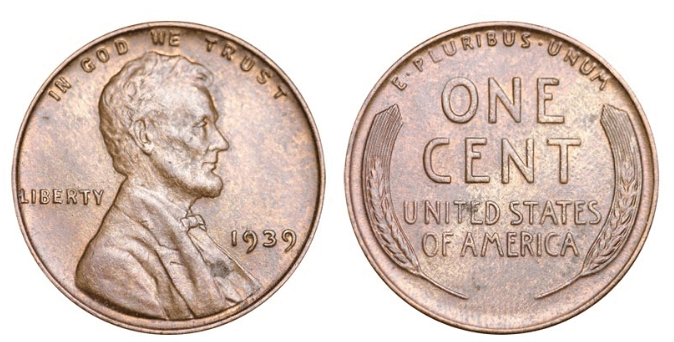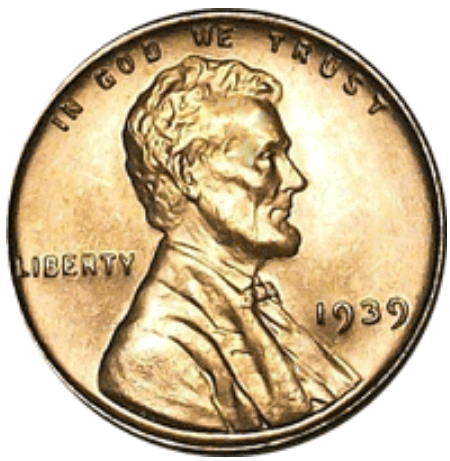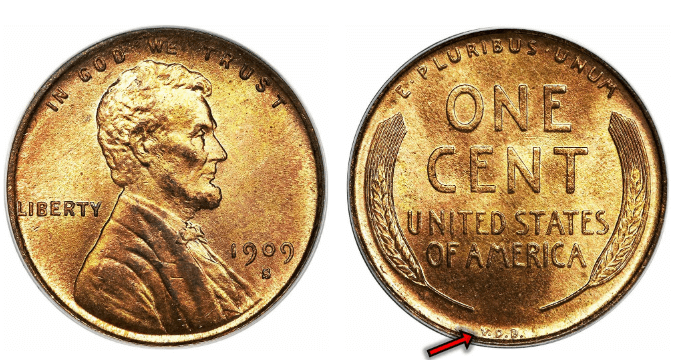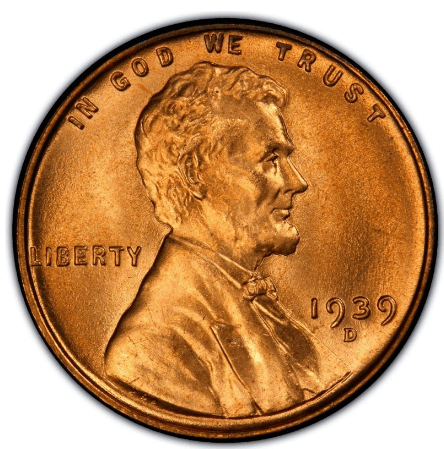1939 Penny Value – Collectors often want to own the 1939 penny. These pennies are a favorite because of their color and simplicity. Due to their color and the pattern of wheat on the reverse, 1939 pennies are also known as wheat pennies.
The 1939 wheat penny, as well as the 1939 D and 1939 S wheat pennies, were produced by the United States Mint. On the obverse side of the coin, below the date, the mint mark may be seen if present. The 1939 penny has a lot of information you should know about it. Continue reading to learn more about the penny.
History Of The 1939 Penny Value
President Theodore Roosevelt voiced displeasure over the United States currency’s lack of aesthetic appeal and qualities in 1904, and the currency was created. The quarter eagle, half eagle, eagle, and double eagle were the four main coins requiring a new design.
The president sent an official communication to the Treasury Secretary, requesting that a private artist assists in the redesign of the four gold coins.
President Roosevelt authorized sculptor Saint-Gaudens Augustus to create a new design for the four gold coins since there was no Congress Act prohibiting the redesign of the coins. In 1908, the design was completed successfully. The cent was thereafter redesigned by the president.
Victor Brenner, a sculptor, created a medal for the Panama Canal Commission in 1908. Fortunately, the President liked his idea for the medal and it was approved. For the first time, Brenner had the chance to create a coin that would feature an American president’s portrait.

An 1864 picture of late President Abraham Lincoln reading a book with his son provided inspiration for him. He suggested several designs for the coin, all of which needed to be altered. Ultimately, the coin was authorized for release by Treasury Secretary Woodin on July 14, 1909.
Follow along as I show you how to calculate the value of your 1939 wheat penny:
- – How to differentiate between a valuable 1939 penny and a common 1939 penny that’s only worth a few cents
- – What is the worth of every 1939 Lincoln wheat penny is.
- – In your pocket change, there’s a list of 1939 pennies you should be on the lookout for.
- – In your spare change, you may find the most common 1939 penny errors and varieties
Okay, now let’s calculate the value of your 1939 Lincoln wheat penny.
How Much Is A 1939 Penny Worth?
If it is in good or very good condition, the 1939 penny with no mintmark is only worth $0.10. It might, however, be worth $1 or $2 if it is in excellent condition. The MS60 penny might be worth up to $3 if it is uncirculated. The MS63 penny, on the other hand, is worth nearly $5. The value of the proof coins is roughly $70 apiece.
In excellent or very good condition, the 1939 penny with S and D mintmarks has a worth ranging from $0.10 to $0.50. The worth of extremely fine coins might climb as high as $2.
1939 Penny Value: Type
In 1939, three types of cents were released. In 1939, the number of low-value coins manufactured continued to rise. The Denver mint, however, was busy refining coins and producing few numbers.
1939 Wheat Penny Value with No Mint Mark (Philadelphia)
The kind struck at the Philadelphia Mint is the most common 1939 Lincoln cent. There is no mint mark (that little letter you see under the date on some Lincoln cents) on these Philadelphia-minted wheat pennies.

In 1939, the Philadelphia Mint produced a total of 316,466,000 pennies, and many of them remain today.
Uncirculated, or unworn, well-worn 1939 Philly-minted pennies sell for 5 to 10 cents each, while well-worn examples may command $1 or more.
In 2006, Professional Coin Grading Service (PCGS) graded an MS-68 Red specimen for $9,775, which is the record price for a 1939 wheat penny.
1939 S Wheat Penny Value
Over 52 million coins were produced by the San Francisco Mint in 1939-S Wheat Penny. In comparison to previous years with the Lincoln Cent series, this was a larger mintage for San Francisco.
In higher uncirculated grades of the brown variety, this might be difficult to locate, but it does seem that some of the higher Mint State grades may be found in red varieties.

In excellent condition, the 1939 S wheat penny is worth roughly $0.15. The worth is roughly $0.75 in excellent circumstances. The value is roughly $1 in superb circumstances.
For coins with an MS 60 grade, the uncirculated price is around $3. Uncirculated coins with a grade of MS 63 are worth around $4.
The high price for Lincoln Cent (Wheat Reverse), 1939-S MS in Auction Record by PCGS MS67+ sold for $3,966.00 in 2013.
1939 D Wheat Penny Value
In 1939, the 9th lowest number of Denver mint variety wheat cents was struck, with 15,160,000 produced. When coins are in above-average condition, they get a premium value. Look at the top ends of the wheat stalks from the reverse angle.
Any remaining lines indicate a lightly circulated coin, which was part of the original design.

The high price for Lincoln Cent (Wheat Reverse), 1939-D MS in Auction Record by PCGS MS68 sold for $11,500.00 in 2009.
1939 Proof Penny Value
The 1939 proof Lincoln wheat cent was minted on specially prepared dies on highly polished planchets (coin blanks) and was made for coin collectors. The Philadelphia Mint produced a total of 13,520. A 1939 proof penny is valued between $35 and $100.
In 2010, however, a superb specimen graded MS-66 Cameo by Numismatic Guaranty Corporation (NGC) sold for $4,025, with frosty design elements and lettering.
Grading The 1939 Lincoln Wheat Penny
Collectors are not fazed by the state of the 1939 Lincoln. The condition of their coins is assessed by a trained professional, and they prefer to have them graded. Coins that are as old as the 1939 Lincoln are graded according to tradition. The following will give you an idea of the many coin grades and how they affect the look of a 1939 Lincoln penny.
The grade must be determined accurately in order to identify an accurate value. It’s critical to have a positive first overall impression of your coin. Even color and minimal markings are positive indicators.
Good Grade: The state of complete smoothness of all major features is called Good Grade on a typical wheat penny in Good grade. Lincoln’s cheek and ear have merged, forming a single flat plane that leads to the forehead. Lincoln’s jaw looks to be very integrated with the remainder of his face, according to a close examination. To identify the jaw from the neckline, a small contour persists. His chin is level with his cheek, but it is raised from the field.
Major distractions are common with high-grade wheat cents. Among the most common reasons for a badly worn coin’s decreased appeal are nicks and stains. When selecting a candidate to add to a collection, collectors evaluate the total eye appeal. Solid for the grade is even toning over a mark-free surface.
Fine: Fine coins have a grade of Fine when they have been circulated for a long time but have avoided significant wear during that circulation. Because of the passing of hands over the years, these pieces may demonstrate indications of smoothing and scratching, but their imagery and wording will nevertheless be plainly legible.
Collectible Errors: If your coin has obvious mint errors, it may be worth a lot of money. Collectible mistakes on a currency distinguish it from other similar versions. Missing pieces of the date, lamination breaks, and planchet clipping mistakes are all to watch out for.
Rarity: As the number of coins in circulation decreases, it becomes more and more valuable. For example, the most valuable and rarest 1939 wheat pennies are found at the San Francisco mint.
MS 60 Uncirculated: There are no signs of wear on MS 60 uncirculated. There may be stains, abrasions, or surface marks on the coin, but it has luster.
PR 63 Proof: This coin has proof 63 surfaces with just a few minor flaws that are close to the key focal points. There aren’t any major problems.
MS 63 Choice Uncirculated: There are some blemishes or contact marks in the major focal areas. The coin’s luster might be less apparent.
Uncirculated Grade: Any part of the design, legends, or fields on an uncirculated 1939 cent are free of signs of wear. At the time of striking, mint frost is left undisturbed.
A region starts at Lincoln’s forehead, runs down his face to his ear, and then finishes at his chin is shown high in the profile. Luster covers these sections on a mint state coin in a fine texture. Wear is reflected in smoothness.
This penny shows off its brightness in a variety of colors. The high regions and low fields have a fresh luster. The brilliance and smoothness of the metal’s delicate texture would be dulled by any wear to these surfaces.
1939 Penny Error List and Varieties
For some coin collectors, identifying errors and variations may be difficult. The reality is, that the majority of coins that their owners believe have a valuable flaw or variety are actually post-mint damage or changes, as seen in most of the photos I’ve seen.
Damaged and altered coins, for example, may include coins with holes, strange scratches, or folds. People often discover such coins in their pocket change.
1939 Doubled Die Penny
When the hub imprints a design on the working die twice and at two slightly different angles, doubled die errors are formed. Every coin produced by the die gets a double image stamped on it. The die is sometimes replaced after it has worn out and is no longer useful.
Nevertheless, frequently when a mint employee discovers the mistake, he or she removes the die and destroys any doubled die coins he or she can locate.
Doubled die coins are uncommon and prized in all situations. Among the 1939 Lincoln wheat cents, there are a number of known doubled dies:
– 1939 Philadelphia doubled die: One major variety exhibits the lettering LIBERTY and the date on the obverse doubled in Philadelphia in 1939. There is limited information on this currency, although comparable currencies sell for $25 or more.
– 1939-S doubled die: A few 1939-S doubled die cents have doubling in the eyelid, which is a little rare. This type of piece might sell for $10 or more.
1939 Penny with Die Breaks and BIE Varieties
When an old die starts to exhibit signs of heavy wear and tear, it’s called a die break. On the struck coin, the cracks appear as raised lines. Depending on the size of the crack and its location, the value and collectability of such a coin may vary.
On the obverse of the coin, just to the left of Lincoln, one of the most popular types of die cracks is one that commonly forms between B and E. The little, vertical die crack takes the shape of a capital letter I, hence they’re called “BIE variants.” The typical price range for BIE varieties is $5 to $10.
– 1939 Wheat Penny With Repunched Mint Mark
The mintmark was hand-punched onto each working die in the 1930s. This provided limitless chances for stamping incidents in which the stamp might be struck multiple times and at various angles or in other locations. Thousands of Lincoln cents, including some among the 1939 pennies, have been discovered with repunched mintmarks. These are mostly worth $3 to $5 each.
– 1939 Wheat Penny With Clipped Planchets
Mistakes in punching out coins from long, thin metal strips from which the blanks come are common. Straight, occasionally crescent-shaped cuts entering the coin are seen as clipped planchet errors. Is there a clip on a 1939 penny? Make sure to keep it safe! Clipped planchets, which might cost $10 to $25 each, are excellent mistakes.
– Off-Center 1939 Penny Error
When the die is incorrectly aligned or a coin is struck outside of its retaining collar, off-center strikes occur. The severity of the mistake and the date’s visibility influence the value of an off-center strike. When the coin is substantially off the square but the date remains fully visible, this is the most valuable kind of off-center mistake.
In general, most off-center pennies worth around $25 is from 1939. Pieces with 50% or more off-center deviation, on the other hand, are worth $75 to $100 or more.
– Counterstamped 1939 Penny
Old pennies with strange letters or designs have been reported by many collectors. Counterstamps, which are a kind of post-mint alteration, account for the majority of them. Several counter-stamped objects were originally utilized as products, such as coupons and other marketing items manufactured by private firms.
These coins, which are part of the realm of exonumia, are often referred to as novelty coins. These counter-stamped coins are highly collectible, and many collectors adore them. Several 1939 Lincoln cents with counter stamps valued at around $1 to $2 are sought after.
Looking for More Information About Coins? Check Other Years From This Lincoln ( Wheat ) Penny Series:
1909 1910 1911 1912
1913 1914 1915 1916
1917 1918 1919 1920
1921 1922 1923 1924
1925 1926 1927 1928
1929 1930 1931 1932
1933 1934 1935 1936
1937 1938 1939 1940
1941 1942 1943 1944
1945 1946 1947 1948
1949 1950 1951 1952
1953 1954 1955 1956
1957 1958
FAQ:
How Much is a 1939 No Mint Mark Penny Worth?
In good condition, the 1939 wheat penny with no mint mark is worth around $0.15. The value is around $0.50 in very good condition. The price is approximately $1 in extremely good condition. Coins with an MS 60 grade sell for around $2 in uncirculated condition.
Are Coins From 1939 Worth Anything?
The 1939-D and the 1939-S nickels are examples of five-cent coins that have a limited and valuable supply. Producing only 3.5 million 1939-D nickels in that year, the figure is a long way from the 10 million that would be expected. 1939-D (Denver) nickels may cost $12 to $200 if they are in good condition.
Is a 1939 Penny Rare?
A total of 383,716,000 pennies were produced in 1939. In the United States of America, Philadelphia, San Francisco, and Denver were the three different mints where minting took place. The most significant number of Lincoln cents issued, 316 466,000, came from Philadelphia.
As a result, the worth of the coin will change depending on its kind. Furthermore, the value of a coin is determined by several factors. The graded 1939 Lincoln pennies are valued in different ways.
Related:
1937 Penny Value
1940 Penny Value
1934 Penny Value
1930 Penny Value